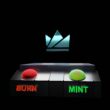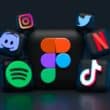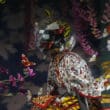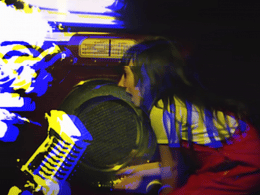Are there any artists in the collection that you’d like to highlight?
So there’s this one artist, C.J, who I really admire. It’s just a bummer because I don’t see her around as much anymore, especially during this bear market. Yeah, it’s like the funds just aren’t there, you know? I hope she’s still out there creating and doing her thing, though. It’s tough out here
Tell us about your new collection “The Beauty Supply is out of Durags”. It revolves around hair which is fascinating to me. Can you share more about it?
So, here’s the deal. The whole idea behind this project is to celebrate our culture, right? It’s all about locks and how it’s relevant to us. And it made perfect sense for me to connect it to the spaces we frequent, like the salon or the barbershop. I mean, think about it, we spend so much time and energy protecting and nurturing our hair, right? We’ve got our du-rags, bonnets, and all that jazz. So I wanted to showcase that vulnerability, that moment when we let our hair down, literally. It’s like revealing our true selves, you know? Sometimes I feel like I’m hiding or not being my complete self, trying to play the game and keep things clean for others. And I know we all do it, unintentionally, of course. It’s just survival mode, you know? And that’s where the beauty supply store comes in. It’s like this secret spot, only those in the know understand its significance. It’s where you go when you need to protect your hair or get the right products. And for me, it was like, “Hey, I’m showcasing what’s under that du-rag or bonnet.” It’s a way of saying, “This is me, unfiltered.” I wanted to bring that out in the collection.

Now, here’s something interesting. Until you mentioned it, I didn’t realize that people with locks wore du-rags too. I thought it was only for waves.
I started off with waves, and as I grew my hair, I transitioned to different styles. From du-rags to bonnets, depending on what suited my hair at the time. But you know what? The process is a journey, man. It takes time, effort, and sometimes it hurts like hell. Especially when you have that Nigerian hair like I do.
And let me tell you, black hair is like politics, bro. It’s so much more than just hair. It’s everything we put into it, the time, the money, the care.
It’s a part of who we are, and it’s deeply intertwined with our identities. So in this collection, I wanted to capture that process, that pain, and that beauty. It’s about showcasing the burdens we sometimes carry when our hair doesn’t fit society’s image of what’s acceptable. You know, the job interviews where they judge you based on your locks instead of your qualifications. It’s a constant battle, man. And in this project, I also wanted to highlight the power and the beauty of our hair. We don’t get enough opportunities to do that, not because we don’t want to, but because the space isn’t always there. So with the blockchain, I wanted to make sure we shine a light on the beauty and significance of locks. And from a personal standpoint, as a black man, I wanted to share my own experiences, how it shapes me and how it may even influence my behavior at times. It’s like there are all these layers to it, you know? But at the end of the day, it’s powerful and beautiful, and I want people to see that. I want them to learn and appreciate our stories through this project
Why are you releasing it on a layer 2 as opposed to Ethereum? Are there any drawbacks or benefits?
So here’s the deal. I was all about getting into Web3 and dropping my blocks, you know? That was the plan. But then, out of the blue, like three months ago, I stumbled upon this platform. They were like, “Hey, we’re all about disrupting, being the punk generals.” And I was like, “Hold up, that’s my jam! Tell me more.” So I hit them up, asking what’s up, and they were super keen to have me on board. And let me tell you, it’s not just about the art for me. I’m all about the narrative, making sure stories and voices are heard. I laid it all out for them, saying, “I need support, I need y’all to be about this.” And you know what? They were on board, ready to be as supportive as possible. That sealed the deal for me. So now, I’m putting my stuff on their platform, and it feels right, you know? Plus, they’re all about tackling homophobia, which is a big deal for me. It was like fate or something, you know? It wasn’t planned, but it just worked out that way.
As for the future, I definitely see some generative work coming. My goal with this collection was to showcase how musicians can collaborate and work together. I had my buddy Daniel Chapman on my team for this one. It’s the first time I’m doing something with a musical component, alongside a vinyl release. Yeah, you heard it right. If you snag a piece from the collection, you can claim a vinyl too. I wanted to show how we can use the technology to connect our music and bring it to life in different ways. It’s not just about the music itself, you know? It’s about exploring the possibilities and making strides in the space that make sense for our careers.
What advice would you give to aspiring artists who are interested in exploring Web3 and utilizing NFTs? How can they effectively navigate and contribute to the digital art landscape while staying true to their creative vision?
As artists, we’re all exploring new stuff and getting into this whole new movement, you know? And let me tell you, it’s not just about specific groups like black folks, but it definitely hits home for a lot of us artists of color. The sad truth is that there’s always this visibility problem, no matter the space or industry. We’re often the last ones to get recognized. But here’s the beautiful part: artists of color have this amazing ability to come together and make things happen, even without all the support. We find ways to make our art shine, you know? It’s all about making it dope, no matter what challenges we face. And let me say, we’re still fighting the same old battles in any space we step into.
But you know what? There’s this innovative technology called Web3 and NFTs that I believe everyone needs to know and learn about. It’s not just about buying an NFT and making money, although that can be pretty sweet. It’s more about being in the loop, getting into conversations, and finding your place in this digital art landscape. I gotta say, platforms like Clubhouse have been amazing for having real talk and learning from each other. And hey, it’s not all about money either. When I first jumped into this space, I didn’t even open a wallet for three whole months! I was more focused on representation, learning from others, and building connections. Of course, eventually, I got into the artist side of things and started shopping around. But what really mattered to me was being able to connect and learn from fellow artists, and making sure we have a safe and supportive environment. So yeah, it’s about embracing this new tech, having some fun, and creating something meaningful together.













